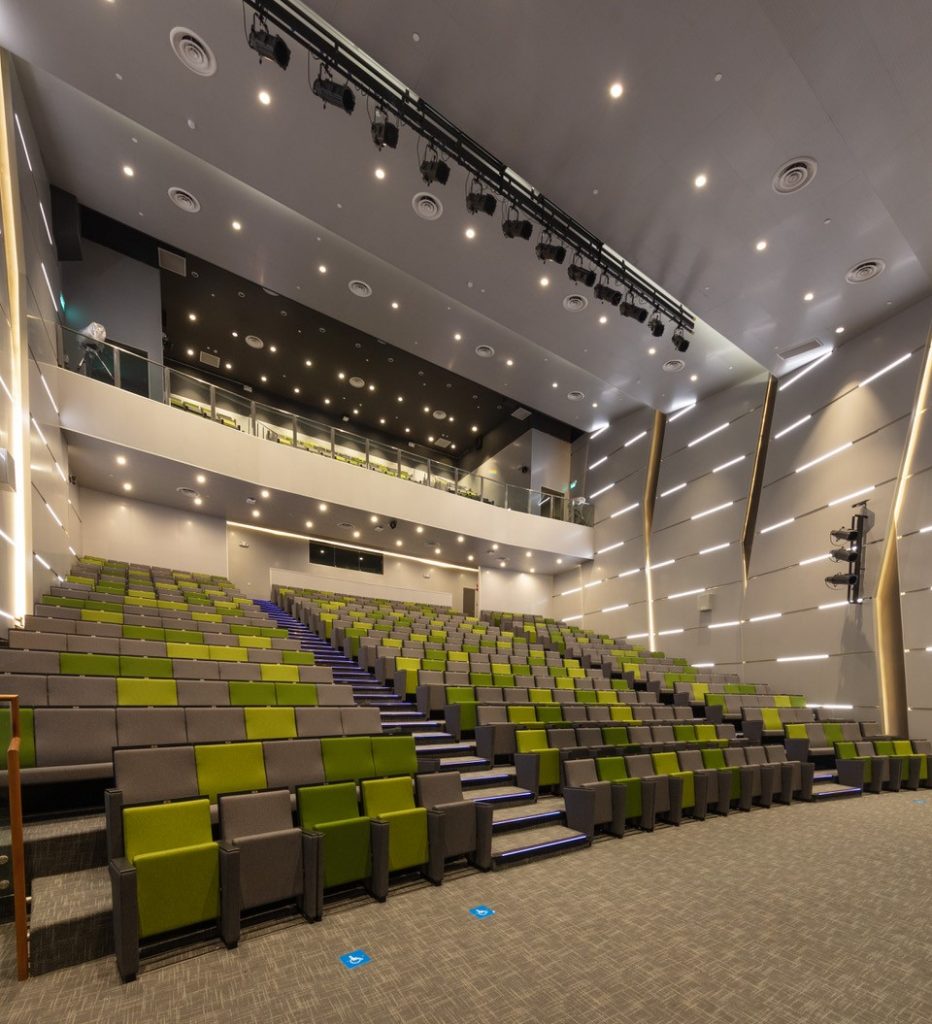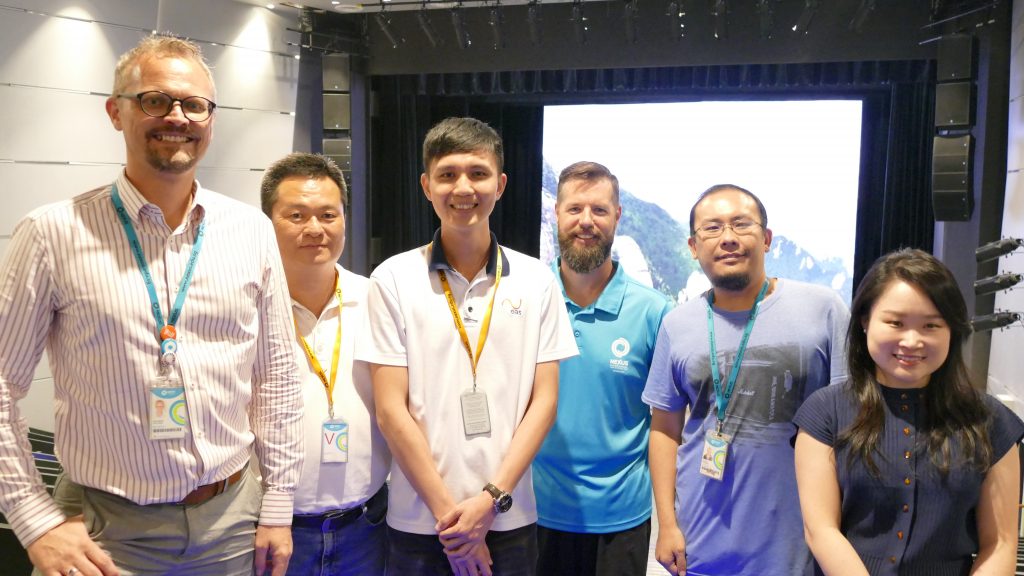Stars of the future
EAS has completed a new auditorium for the Nexus International School (Singapore) where students can learn drama and technical skills in style. Richard Lawn visits the new campus
The completion of a 600-capacity auditorium at the Nexus International School (Singapore) was all in a day’s work for AV and lighting systems integrator, Electro-Acoustics Systems (EAS). However, for the more-than-satisfied school, the building is the crowning focal point of its new, wholly owned premises.
Nexus, which welcomed its first students in July 2011, embarked on building its own school, relocating from Pandan Valley to the new Aljunied campus in January 2020. The school recognises that teaching is no longer confined to four walls, creating open and flexible spaces with areas where children can exhibit their work, collaborate or work alone in quiet zones. Facilities within the 12-storey campus include design and technology rooms, an aquatic centre with Olympic-sized swimming pool, two gymnasiums, a double-storey library and an AstroTurf playing pitch. Music lessons have been significantly enhanced by recording and mixing studios and soundproof classrooms.
Brought to life by EAS, the newly constructed two-tier theatre could easily be envisaged as a premium commercial venue. The company also created two black box drama suites for performing. For the starry-eyed under-18 performers and their teachers, the 13m-wide stage is set to inspire those in the spotlight, while for the 600-capacity audience, the column-free vista provides good sightlines from every comfortable seat.
“User-friendliness and ease-of-use functionality remain our key client requirements in educational settings,” explains EAS executive director, Tze Tze Lam. “The teachers specified the design they had in mind. Our role was to fully comprehend these requirements and make the school aware of the various options available. Preparations began several years before construction started, which helped. Over time, technology changes rapidly, but the school was receptive to our suggestions to make upgrades that would benefit them while staying within budget and the existing specifications set by Acviron Acoustics principal consultant, Dr Lim.”
Called to site in late 2019, 12 months after groundbreaking, EAS assistant project manager Chester Tan initially oversaw the integration of the loudspeaker, HDMI, VGA and network infrastructure. While the school is future-proofed to accommodate 2,000 students, there are also more than enough data points for the years ahead. The EAS installation team for the four-storey theatre consisted of 15 engineers, installers and a safety assessment expert. Due for completion in August 2019 prior to the new school year, construction delays meant that the official opening would be postponed by four months.
Nexus’ AV music technician Tee Zhang can control all the AV, lighting, drapes and HVAC parameters from a Crestron Control app on an iPad. A rack-mounted Crestron AV3 processor programmed by EAS is central to all AV operations, while an isolated control subnet provides a dedicated Gigabit Ethernet LAN for all the Crestron-controlled devices.
The auditorium’s main focal point is a framed 2.9mm pixel pitch Sansi LED measuring 9m x 7.5m, behind the main stage. Routed to the Crestron network via a DM NVX 4K60 4:4:4 HDR network AV encoder/decoder, the 4K LED is the sole output apart from three Samsung HD monitor displays. Six NovaStar MCTRL500 LED controllers provide video processing connected to a CVI320 network switcher and LightWare HDMI fibre transmitters and receivers.
Four facility panels incorporating speakON, Kramer HDMI and VGA input connections provide venue flexibility when positioning the stage lectern. In addition to a Blu-ray player, six fixed Panasonic AW-4HE40 HD PTZ cameras are managed by a single AW-RP50 controller. Inputs are switched on a Datavideo SE-2200 six-channel effects matrix, with an HDR-70 HD-SDI recorder for special occasions, such as musical performances and graduation ceremonies.
L-R line arrays of five Renkus-Heinz Varia 101i-7 modules per side provide the main FOH audio for the tapered theatre. Incorporating a single 10-inch LF woofer with dual 1-inch HF compression drivers, the self-powered VA101i-7 can be arrayed from 0–7.5° in 1.5° steps. Low-frequency extension beyond 80Hz (±3dB) and down to 35Hz is provided by two-per-side CX118S subwoofers suspended above each of the arrays. Front and balcony fills consist of four CX121 12-inch and four dual 4-inch CX42 loudspeakers, respectively, while foldback monitoring is provided by Renkus-Heinz CFX121M wedges.
The Dante network offers NISS uncompressed, multichannel, low-latency digital audio over Ethernet using Layer 3 IP packets. Incorporating Lake signal processing parameters, the loudspeaker system is powered by eight Lab.gruppen D Series four-channel amplifiers. The D 40:4L, D 20:4L and D 10:4L models serve as the Dante network connection between the Renkus-Heinz loudspeaker outputs and digital inputs.
The glazed operations room at the rear of the venue houses a Yamaha QL5 console in 32+2 fader configuration. A Shure QLX-D wireless system including handheld and tie-clip transmitters, together with wired Shure SM57 instrument and SM58 vocal mics, are fed into a Rio3224-D stage rack and out to the QL5 for mixing. Various DSP room configurations have been stored in a Yamaha MTX5-D processor.
For students preferring not to be in the glare of the Robert Juliat Lucy 1449 follow spots, back of house operations may be of greater appeal. Here, the comms system consists of wired CC-300 headsets and FreeSpeak II wireless beltpacks. Equipped with 18-inch goosenecks, a Clear-Com MS-702 two-channel master station with remote station can be used for operations. The UHF signals of the Shure QLX-D system are boosted by UA874 and UA844 antennas and boosters, while Clear-Com intercoms are enhanced by FSII wall-mounted active antennas and splitters.
The extensive lighting setup comprises five cyclorama LX bars, two bridges, left- and right-hand side spots, moving heads and followspots. From the control surface of an ETC Ion Xe console connected to a 20×1 fader wing, the ambience of the theatre is monitored from a 22-inch display. Overhead and side fixtures include ETC Source Four Fresnels and zooms, together with ETC ColorSource LED spots and PARs. Eight Martin Rush MH1 moving head washes and profiles add further dazzle if required, once the J&C Joel motorised drapes have been drawn.
Dante connectivity extends to the two black box theatres, both outfitted with audio, lighting and video systems. Powered and networked by Lab.gruppen Class D four-channel amplifiers, four Renkus-Heinz CX121 speakers augmented by dual CX118S subwoofers are fixed to ceiling-suspended steel pipe truss frames in each theatre. Yamaha QL1 mixing consoles, Renkus-Heinz CX81 wedges and Shure ULX-D wireless microphones complete the audio setup. Video inventory includes Panasonic PTZ cameras fed into a Datavideo matrix switcher, with Epson 8,000-lumen LCD laser projectors selected for brightness and low-maintenance performance. ETC dimmers and Source Four fixtures are controlled from an Ion Xe interface, while Crestron iPad control extends the ease-of-use features. Crucially, flexibility is the main criteria, and this has been added with the insertion of customised panels incorporating XLR mic inputs and DMX outlets.
Given the number of higher educational facilities that industry veteran and EAS senior project manager Patrick Chee has been involved with over two decades at the company, he should possibly consider teaching AV installation to others. “We tend to be successful with our bids as we are quite unique in what we offer,” he says. “With our in-house expertise, EAS doesn’t need to involve third parties and, as such, we don’t need to sub-contract any of the works. That saves us time and – most importantly perhaps – it offers the client a much better guarantee of quality.”
“Seeing the amount of work that had to be completed back in September, the extended December deadline looked challenging,” comments Nexus’ marketing executive, Jeremy Lewis. “However, when EAS came to complete the theatre and black box rooms, it was like watching a military team transform the venues once they had terminated the connections. Our state-of-the-art theatre will continue to impress our guests just as much as it will inspire our students for many years to come.”




Source: https://issuu.com/blankcanvaspublishing/docs/pro_avl_asia_september_october_2020/64
